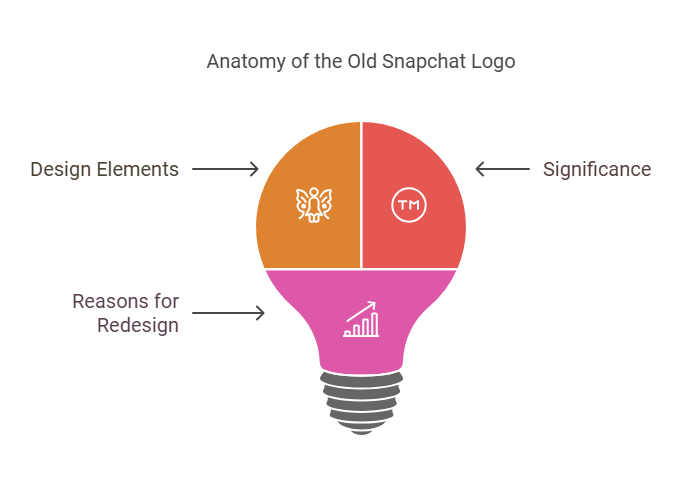old Snapchat logo
old Snapchat logoSnapchat, one of the most iconic social media platforms today, has gone through significant transformations since its inception in 2011. Among its most recognizable features is the Snapchat logo—the playful ghost that has become synonymous with fleeting messages and ephemeral connections. While the current logo is widely recognized, the old Snapchat logo holds a special place in the hearts of early adopters and design enthusiasts alike. This article delves into the history of the old Snapchat logo, its design evolution, and the impact it has had on branding in the digital age.

The Origins of Snapchat and Its Iconic Ghost
Snapchat, initially launched as “Picaboo,” was created by Evan Spiegel, Bobby Murphy, and Reggie Brown while they were students at Stanford University. The app’s primary feature was its ability to send self-destructing photos, a novel concept at the time. Alongside its unique functionality, Snapchat needed a logo that would reflect its playful and unconventional nature.
The logo was inspired by the platform’s original name, “Picaboo,” which referenced the game “peek-a-boo.” This led to the creation of a ghost mascot, symbolizing the fleeting nature of snaps. Named “Ghostface Chillah” as a nod to Ghostface Killah of the Wu-Tang Clan, the logo became an integral part of Snapchat’s identity.
Design Elements of the Old Snapchat Logo
The old Snapchat logo was simple yet effective. Key elements included:
- The Ghost Silhouette: The logo featured a white ghost with a playful and slightly asymmetrical design. Its quirky shape gave it a friendly, approachable vibe.
- Yellow Background: The bright yellow background made the logo stand out among the predominantly blue-themed social media icons of the time, such as Facebook and Twitter.
- Minimalistic Style: The logo lacked intricate details, emphasizing simplicity and clarity—qualities that aligned with Snapchat’s straightforward functionality.
- No Facial Features: The ghost was faceless in the original logo, allowing users to project their own interpretations onto it, which enhanced its universal appeal.
This design was both memorable and distinctive, helping Snapchat gain a foothold in the competitive world of social media apps.
The Evolution of the Snapchat Logo
As Snapchat grew in popularity, its branding underwent several changes to reflect its evolving identity:
- 2013 Redesign: The old Snapchat logo saw its first major update in 2013. The ghost was given a bolder outline, enhancing its visibility and making it more recognizable.
- Facial Features Addition: For a brief period, the ghost was adorned with facial features. However, this change was met with mixed reactions, and Snapchat soon reverted to a simpler design.
- 2019 Simplification: The logo was refined further, with smoother lines and a cleaner silhouette. This modernized version retained the essence of the old Snapchat logo while adapting to contemporary design trends.
Throughout these iterations, the ghost mascot remained central to Snapchat’s identity, showcasing the brand’s commitment to its roots.
Why the Old Snapchat Logo Resonates with Users
The old Snapchat logo holds nostalgic value for many early users who associate it with the platform’s initial charm. Reasons for its enduring appeal include:
- Simplicity: The minimalist design made it easy to recognize and remember.
- Playfulness: The quirky ghost symbolized fun and spontaneity, qualities that defined Snapchat’s user experience.
- Cultural Relevance: The ghost’s name, “Ghostface Chillah,” added a layer of cultural resonance that appealed to a young, tech-savvy audience.
- Distinctiveness: In a sea of social media logos, Snapchat’s bright yellow background and ghost mascot stood out, making it instantly identifiable.
The Impact of the Old Snapchat Logo on Branding
The old Snapchat logo played a pivotal role in establishing the brand’s identity. Key lessons from its success include:
- Consistency: Despite design updates, Snapchat has retained its core elements, ensuring brand recognition.
- Bold Choices: The use of a yellow background was unconventional but effective, proving that bold design decisions can pay off.
- User Connection: The playful and relatable design resonated with Snapchat’s target audience, fostering loyalty.
Snapchat’s logo evolution demonstrates the importance of balancing innovation with consistency in branding.
FAQs
1. What was the old Snapchat logo? The old Snapchat logo featured a white ghost with a playful silhouette against a bright yellow background. It was simple, minimalistic, and lacked facial features.
2. Why did Snapchat choose a ghost for its logo? The ghost symbolizes the ephemeral nature of Snapchat’s messages, which disappear after being viewed. It aligns with the platform’s core concept of fleeting communication.
3. When did Snapchat update its logo? Snapchat has updated its logo several times, with major changes occurring in 2013 and 2019. However, the core elements of the ghost mascot and yellow background have remained consistent.
4. What is the significance of the yellow background in Snapchat’s logo? The yellow background helps Snapchat stand out among other social media platforms and conveys energy, creativity, and playfulness.
5. How has the Snapchat logo impacted its branding? The Snapchat logo has been instrumental in establishing the brand’s identity. Its unique design and bold choices have made it one of the most recognizable logos in the digital space.
Meta Description:
Explore the history and evolution of the old Snapchat logo. Learn how this iconic ghost design shaped Snapchat’s brand identity and its impact on social media branding.
